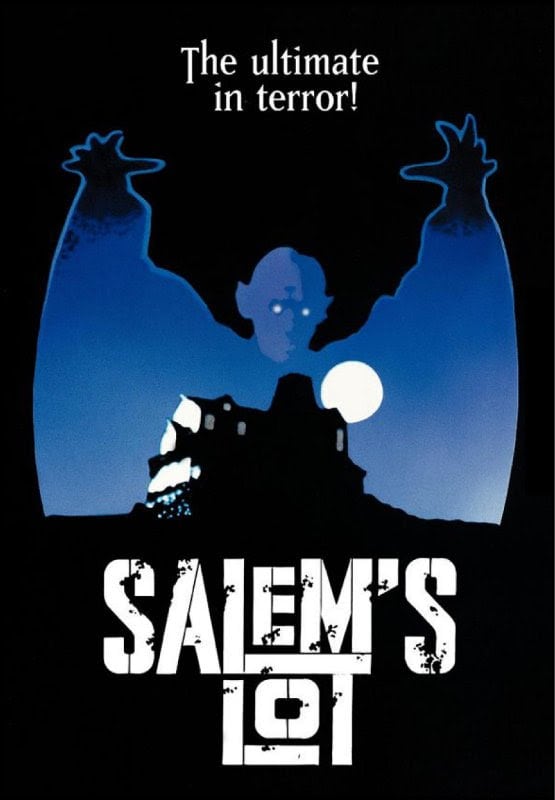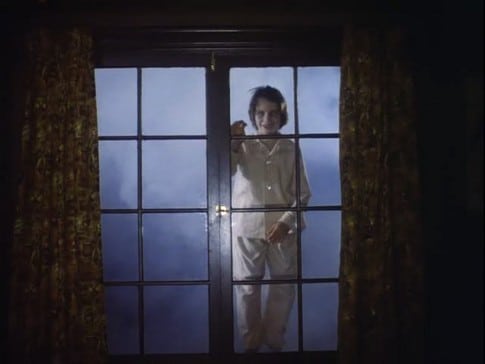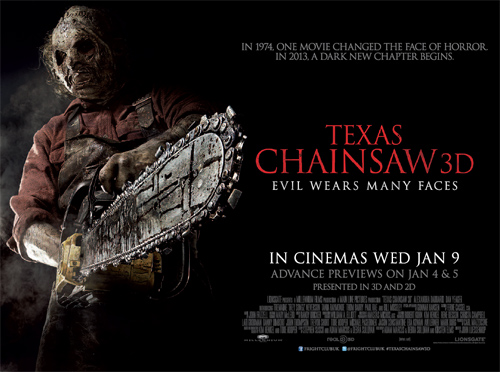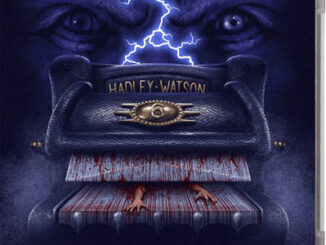Salem's Lot (1979)
Directed by: Tobe Hooper
Written by: Paul Monash, Stephen King
Starring: Bonnie Bedelia, David Soul, James Mason, Lance Kerwin
HCF REWIND NO. 160: SALEM’S LOT [1979]
AVAILABLE ON DVD
RUNNING TIME: 184 min [two 92 min episodes]
REVIEWED BY: Dr Lenera, Official HCF Critic

Ximico, Guatemala. A man and a boy are filling small bottles with holy water. When one of the bottles begins to emit an eerie supernatural glow, Ben Mears tells Mark Petrie: “They’ve found us again.” We flash back two years to the small Maine town of Salem’s Lot. Ben is a writer who has returned to the town after a long absence to write a book about the Marsten House, an ominous old property on a hilltop which has a reputation for being haunted and which he had a traumatic experience in when he was a child. It has been bought by another new arrival, antique dealer Richard Straker, whose business partner Kurt Barlow seems to be always absent. Ben becomes romantically involved with a local girl, but then two other locals are asked by Richard to transport a coffin in the middle of the night….

It is night time and the young boy is stirring in his bed, something gradually waking him up. He looks out at the bedroom windows and fog starts to appear outside, getting thicker and thicker until a figure can be seen floating within. It is his best friend Ralphie, and he taps on the door crying: “Let me in”. Now this may not sound like something especially scary, but said scene is notorious for scaring and damn near traumatising kids who watched Salem’s Lot when they first saw it on TV. Us Brits got it a few years later than the Americans because a cut-down version got into UK cinemas in 1979 the same year as the two-part mini-series was shown in the US. When that kid appeared at that window, I can still, even now, remember the shivers down my spine and wanting to turn the thing off, but of course I carried on watching. Was it Ralph’s arm, which moved as if it was on strings like a puppet? Was it the pasty-faced and cat-eyed vampire make-up which almost become the de rigueur look of nosferatu in the 80’s? Was it the tremendously eerie score? Of course it doesn’t seem frightening now but it made such a huge impression on me at the time, as did the whole mini-series, which remains a high point of TV horror and the best vampire thing ever done for the medium, though it does have flaws which even lovers like me cannot ignore!
Salem’s Lot was originally intended to be made for the big screen, influenced by the great success of the Stephen King adaptation Carrie. Three unsatisfactory screenplays were written and George Romero was slated to direct. Nosferatu The Vampyre and Dracula were put into production, so Warners decided to make it for TV and Romero dropped out because he would have felt too restricted by TV censorship, something that eventual director Tobe Hooper [The Texas Chainsaw Massacre] was happy to work in. Paul Monash’s script simplified much of the book including deleting or combining characters and removing subplots, but King was pleased [and he was certainly not afraid of criticising an adaptation, such as The Shining, if he felt it was warranted], even with the violence having to be toned down. The theatrical version which was shown in Europe removed nearly an hour [mostly from the first third] but featured slightly stronger alternate versions of three scenes, most notably when Cully Sawyer threatens Larry Crockett with his shotgun, which in the TV version was just pointed at him but in the cinema version was put in his mouth like in the book. Oddly enough, the DVD keeps the TV version of that scene but has the cinema edits of the other two altered scenes. In 1987 came a mediocre sequel A Return To Salem’s Lot and in 2004 it was remade as another TV mini-series. It contained more of the novel but far less of its feel. For me, there is only one Salem’s Lot.
Salem’s Lot’s first minute is devoted to brief highlights of what you are about to see in the next three hours, and it’s very off putting, always causing me to skip this bit on the DVD, though that’s how it was shown on TV, and I guess it was put there to warn viewers of the horror to come and to stay away if they didn’t feel they could handle it! Then we switch to the ficticious Guatemalan town of Ximico, and I’ve read much criticism of the two scenes that bookend the rest of the story [they were removed from the theatrical cut], but they give the whole thing a more expansive, even epic, feel . The next hour is devoted to slowly establishing and setting up characters and setting, and it is quite slow paced, but really has that sleepy small town feel essential to much of King’s work. Much time is devoted to the romance between Ben and Susan Norton, and it’s rather sweet, while there’s also a subplot about involving a tarty wife who’s cheating on her husband. Said subplot climaxes in a really tense and sweaty scene, full of human fear, where the husband threatens the other guy with a gun. I suppose it’s not important to the main story, but it adroitly shows what ‘real’ terror is, something that happens in real life, as opposed to ‘fantasy’ terror, and King often added in things, themes which he would repeat in other stories, which are not essential and not always developed but add flavour. Most notable in Salem’s Lot is the idea of the Marston House being a living evil entity in itself.

Despite its leisurely pacing, there is a constant brooding atmosphere, enhanced no end by Harry Sukman’s ominous music which intelligently mixes in the Dies Irae [the oft-used Latin hymn of the dead], and we get lots of shots of the house and footage of Straker, superbly played by James Mason in what is for me the best of his later performances filled with calm menace and almost subliminal hints of underlying evil, to maintain the feeling that stuff is going to happen. Which it eventually does. Now Salem’s Lot is a TV movie and thereby has a TV feel that it can’t escape, but Hooper makes it seem as cinematic as he can and pulls off some scenes which wouldn’t normally be seen amidst the conveyor belt production line of TV, like a lengthy tracking shot through a wood to reveal a dead dog. As well as the scene I mentioned at the start of this review, there’s also a tremendous bit where Ralphie’s father goes to his grave and opens it. We see Ralphie lying there, cut to his father’s face, then suddenly the boy’s face pops out of the left side of the screen in a superbly timed jump scare. The other bit that really ‘got’ me as a kid was when we finally get to see Straker’s mysterious partner Barlow properly, a vampire so powerful that a bloody earthquake precedes his appearance. We are suddenly aware of a cloak on the kitchen floor, and it gets bigger and bigger as something stands up inside it to reveal Barlow who quickly smashes a boy’s parents heads together, wearing hideous makeup that is modelled on that in Nosferatu and is closer to what Max Schreck wore than both the Klaus Kinski and Willem Dafoe versions.
Actor Reggie Nalder says that they cut out lots of his scenes as Barlow, though I can’t see what they would have been, the decision having been taken to change him from a Dracula-like attractive vampire to an ugly bogeyman working well anyway. There are a few signs elsewhere of footage cut, with the odd scene seeming to cut away before it had ended, and a few things not explained. The general lack of blood isn’t really missed. A bigger flaw overall is that Salem’s Lot doesn’t really ramp up the pace when it should towards the end. The interior of the Marsten House is creepy, and Hooper pays at least two homages to Psycho, but things don’t reach a higher level of excitement. They also get very silly, with one person suddenly displaying superhuman strength. The final scene is really strong though and affected me in another way as a child. It somehow told me what true love, something I wasn’t really familiar with, could be. Someone can be a blood-sucking monster and still feel love. It’s all very downbeat really, ending with our two heroes living a nomadic existence, being constantly on the run from vampires.
David Soul is too bland and un-emotive as Ben, but he is surrounded by a great supporting cast. Of course as a child I was most taken with young Mark, the boy obsessed with monsters and has a bedroom full of cool posters and models, a boy much like myself at the time though I didn’t have the cool posters and models! I like to think though, like Mark, I would have been able to deal with the horrifying events he has to deal with. Looking at Salem’s Lot objectively, three hours is an awful long time to spend on what is little more than a variation on the second and final thirds of Dracula, and it probably would have been better as a cinema production – you can even tell where the advert breaks would have been, while the compromises aren’t always well handled. You even get things like a silly freeze-frame claw. Overall though they did a very good job considering the constraints. There’s always the argument that letting the imagination run riot is more effective anyway. Christ, mine certainly did those two fateful nights.







I liked your review of a great mini-series, but a few notes — you wrote of the Ralphie Glick window scene “It is his best friend Ralphie, and he taps on the door crying: “Let me in”. Actually, the kid in the bed is Danny Glick, who is Ralphie’s older brother, not his best friend. Also, Ralphie never cries “Let me in.” He never says a word during either of his nighttime visits to his brother.
You also wrote “there’s also a tremendous bit where Ralphie’s father goes to his grave and opens it. We see Ralphie lying there, cut to his father’s face, then suddenly the boy’s face pops out of the left side of the screen in a superbly timed jump scare. ” You’re referring to the Danny Glick funeral scene. Danny Glick was in the grave, not Ralphie. And it was the gravedigger character, Mike Ryerson, who jumps into the grave, not Mr. Glick.
Thanks for your corrections! I think I wrote that one late at night immediately after watching it! This has reminded me I still need to get around to watching and revieweing the remake…
I appreciate your review of the 1979 as adaptation of Stephen King’s Salem’s Lot. I was going to point out the notes made in the previous comment
But someone beat me to it. But there is a couple of notes I would like to point out in that David Soul’s portrayal of Ben Mears was actually pretty good. It took away from the rather bookish, boring description of Ben in the book with a fresh familiar face. As for Reggie Nalder as Barlow, much of the reason that so little was seen of him in the movie is he had problems with his makeup and teeth falling off and out and the contact lens that were used by all who played vampires could only wear them for 15 minutes at a time with 30min rest periods because they were so uncomfortable to wear. Even Reggie admitted that he would have liked to have seen more of his Barlow character than what was shown. Overall, I did like your review of my all-time favorite vampire movie.